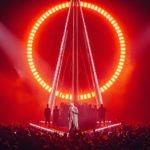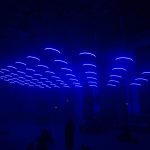A couple of months ago, I came face to face with the realization that all I had known to be true about diffusion was little more than illusion. For several years I put those little square pieces of plastic in front of my luminaires to magically transform the subject by changing the quality of the light. But by sheer accident I found it wasn’t changing it as much as I thought. I was recently commissioned to write an instruction booklet about lighting design. When the text was finished, I went about illustrating it, creating graphics and taking pictures to illustrate certain points. When I downloaded the pictures and saw them on the computer, I realized the shots of diffusion didn’t look like I expected.
I use diffusion for one primary reason: to soften the light. Soft light makes soft shadows and great pictures. It smoothes wrinkles and renders age lines virtually invisible. Think of a textured wall, like the ones in your house. When it’s illuminated by focused, directional light, the texture stands out and you can see every detail in the wall. But with softer, more diffuse light, the texture all but disappears. Diffusion scatters and softens light. At least, that’s what I thought. But the pictures I saw didn’t bear that out.
For my illustrations I used a basketball because it has a nice bumpy texture and an orange color. I carefully set up my camera on a tripod and an ETC Source Four where I would normally put my key light. I then took a series of pictures starting with no diffusion and working my way through every piece of diffusion material, from light to heavy, that I could put my hands on. As I was placing the diffusion in the fixture I could see the field widen — a telltale sign that the diffusion is scattering the light.
When I finally looked at the pictures, much to my surprise, I couldn’t tell the difference between those with light diffusion and those with medium to heavy diffusion. The shadow of the basketball was clearly very sharply defined, unlike the soft shadows I was expecting. And the dimples of the basketball were totally visible in all the pictures. At best, I could only see a slight difference between the pictures with no diffusion and those with heavy diffusion. What went awry?
I scratched my head and then called somebody a lot smarter than me — Josh Allemany of Rosco, whose last name, I think, translates roughly to “Einstein” in Yiddish. I quizzed Josh about their diffusion, and he was gracious enough to send me a sample of every type of diffusion material that Rosco makes. I then took the sample pack to Westlake High School in Austin where my friend David Poole is the theatre tech director, and I borrowed their theatre to unlearn and relearn everything I could about diffusion.
I essentially repeated my photography session with the basketball, one Source Four, and a variety of diffusion. My sense was that the effectiveness of the diffusion was somehow related to where it was placed in the path of the beam. I thought that by placing it further away from the fixture it would be more effective. Also, since my original pictures were shot in my small studio, I was forced to use a very short throw. This time I would have a much longer throw. Instead of simply placing the diffusion in front of the Source Four, I varied the distance between the luminaire and the diffusion by holding it in place.
I took over a hundred pictures, and this time they came out differently. The shadows were much softer in all the pictures, leading me to believe that effectiveness of the diffusion is related to the throw distance; the longer the throw, the more effective the diffusion. But the texture of the ball was still plainly visible. Based on the outcome of the pictures, I now believe that there are certain things diffusion can do and certain things that it cannot do.
Diffusion does:
•Spread the field; the heavier the diffusion the more it spreads the field.
•Soften shadows; the longer the throw, the more scattered the light and the softer the shadows become.
•Decrease the intensity of the illumination; the heavier the diffusion, the greater the light loss.
On the other hand, diffusion does not convert a point source, like a Leko, to a linear source like a Kinoflo.
It seems to me that no matter how much diffusion you use in a point source, it’s very difficult to obscure textures and age lines. Linear sources and very large sources, like a large diameter Fresnel, do that best. Perhaps that’s why the “jewel” method of lighting, where you surround the subject with many sources, is so popular in Hollywood — it approximates a linear source. If the McCandless method with three points of light is good, then the jewel method with six or so points of light is excellent. Add diffusion and it becomes pure magic.
What still confounds me is the tradeoff between soft light and spill control. The more scattered the light, the more difficult it is to place it where it belongs and keep it away from where it does not belong. And the longer the throw, the more difficult a problem it becomes. Someone cleverer than I should invent a soft light with a very long throw to use in applications where IMag is being used in conjunction with a live audience. The presence of a live audience precludes the use of large soft boxes, which can interfere with lines of sight, and large Fresnels lack the control of a long throw Leko.
Diffusion is a wonderful and necessary tool for the lighting designer, but it has to be used properly to get the right results. This little foray into the application of diffusion was a great eye opener. When you’ve been working on assumed knowledge for many years and then you find out you weren’t quite on the mark, it can shake the core of your existence. And that can be a very good thing.
Don’t hide in the shadows. E-mail the author at rcadena@plsn.com.


